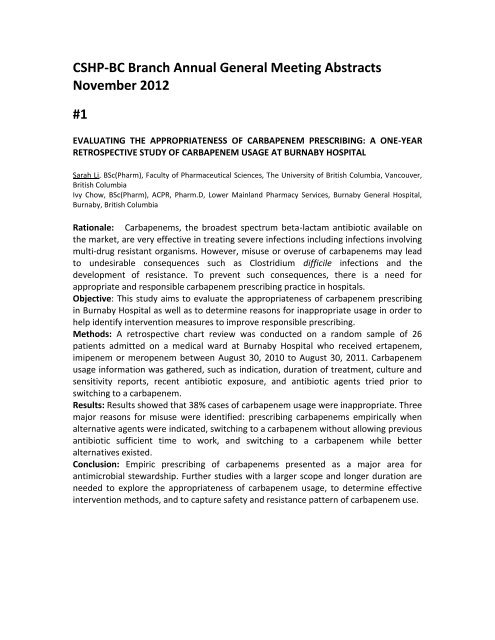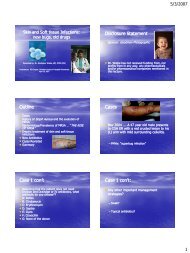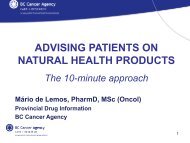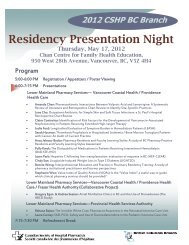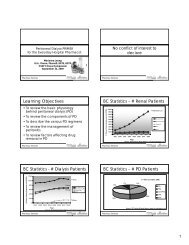Download Abstracts - CSHP-BC Branch
Download Abstracts - CSHP-BC Branch
Download Abstracts - CSHP-BC Branch
You also want an ePaper? Increase the reach of your titles
YUMPU automatically turns print PDFs into web optimized ePapers that Google loves.
<strong>CSHP</strong>-<strong>BC</strong> <strong>Branch</strong> Annual General Meeting <strong>Abstracts</strong><br />
November 2012<br />
#1<br />
EVALUATING THE APPROPRIATENESS OF CARBAPENEM PRESCRIBING: A ONE-YEAR<br />
RETROSPECTIVE STUDY OF CARBAPENEM USAGE AT BURNABY HOSPITAL<br />
Sarah Li, BSc(Pharm), Faculty of Pharmaceutical Sciences, The University of British Columbia, Vancouver,<br />
British Columbia<br />
Ivy Chow, BSc(Pharm), ACPR, Pharm.D, Lower Mainland Pharmacy Services, Burnaby General Hospital,<br />
Burnaby, British Columbia<br />
Rationale: Carbapenems, the broadest spectrum beta-lactam antibiotic available on<br />
the market, are very effective in treating severe infections including infections involving<br />
multi-drug resistant organisms. However, misuse or overuse of carbapenems may lead<br />
to undesirable consequences such as Clostridium difficile infections and the<br />
development of resistance. To prevent such consequences, there is a need for<br />
appropriate and responsible carbapenem prescribing practice in hospitals.<br />
Objective: This study aims to evaluate the appropriateness of carbapenem prescribing<br />
in Burnaby Hospital as well as to determine reasons for inappropriate usage in order to<br />
help identify intervention measures to improve responsible prescribing.<br />
Methods: A retrospective chart review was conducted on a random sample of 26<br />
patients admitted on a medical ward at Burnaby Hospital who received ertapenem,<br />
imipenem or meropenem between August 30, 2010 to August 30, 2011. Carbapenem<br />
usage information was gathered, such as indication, duration of treatment, culture and<br />
sensitivity reports, recent antibiotic exposure, and antibiotic agents tried prior to<br />
switching to a carbapenem.<br />
Results: Results showed that 38% cases of carbapenem usage were inappropriate. Three<br />
major reasons for misuse were identified: prescribing carbapenems empirically when<br />
alternative agents were indicated, switching to a carbapenem without allowing previous<br />
antibiotic sufficient time to work, and switching to a carbapenem while better<br />
alternatives existed.<br />
Conclusion: Empiric prescribing of carbapenems presented as a major area for<br />
antimicrobial stewardship. Further studies with a larger scope and longer duration are<br />
needed to explore the appropriateness of carbapenem usage, to determine effective<br />
intervention methods, and to capture safety and resistance pattern of carbapenem use.
#2<br />
THE USE OF SELF-ADMINISTERED MEDICINAL CANNABIS FOR CYSTIC FIBROSIS<br />
SYMPTOM MANAGEMENT: PATIENT-REPORTED EXPERIENCES.<br />
Shalansky, Stephen 1 ; Lee, Kathleen MN 2 ; MacDiarmid, Pat 2 ; Wilcox, Pearce 2<br />
INSTITUTIONS: 1. Pharmacy, Providence Health Care, Vancouver, <strong>BC</strong>, Canada. 2. Adult Cystic Fibrosis<br />
Clinic, St. Paul, Vancouver, <strong>BC</strong>, Canada.<br />
Rationale: A number of adult Cystic fibrosis (CF) patients attending our clinic have<br />
disclosed their use of cannabis for symptom control. To our knowledge there have been<br />
no studies examining efficacy of cannabis in the CF population.<br />
Objective: To determine the frequency of cannabis use for symptom control amongst a<br />
cohort of adult CF patients, reasons for use, and perceived efficacy.<br />
Methods: A letter was mailed to all 215 patients registered with the Adult CF Clinic at St.<br />
Paul's Hospital inviting them to participate in an anonymous web-based survey. Those<br />
indicating use of cannabis were asked questions regarding demographics, symptoms<br />
managed, method of delivery, and perceived efficacy.<br />
Results: Of the 85 respondents (40%), 22 (26%) indicated cannabis use for medicinal<br />
reasons. Nineteen (85%) were male and twelve (55%) were over the age of 30. Of the<br />
19 cannabis users who completed the full survey, 11 (58%) indicated daily use. The<br />
most common methods of delivery were mixing with food (79%), smoking (68%) and<br />
vaporizing (63%). Most patients indicated that cannabis improved symptoms including<br />
appetite (84%), sleep (79%), anxiety (79%), pain (74%) and respiratory symptoms (53%).<br />
Subsequent to the survey, clinic staff reported an increase in questions regarding<br />
cannabis use, which has facilitated more open discussion regarding potential risks and<br />
benefits.<br />
Conclusions: Cannabis is commonly used by adult CF patients, and the majority of users<br />
perceive improvement in target symptoms. Potential lung damage through the<br />
inhalation of cannabis via smoking and vaporizing is of concern and should be discussed<br />
with CF patients who disclose cannabis use.
#3<br />
EXPOSURE TO MATERNAL MEDICATIONS - A CASE OF NEONATAL “LOCK-JAW”<br />
Brandi Newby, BScPharm, ACPR, Surrey Memorial Hospital, Surrey, <strong>BC</strong><br />
Rebecca Sherlock, MD, FRCPC, Surrey Memorial Hospital, Surrey, <strong>BC</strong><br />
Rationale: Many infants are exposed to psychoactive medications during pregnancy.<br />
Extrapyramidal symptoms have occurred in infants born to mothers taking antipsychotic<br />
medications. The specific symptom of “lock-jaw” has not been previously reported in<br />
infants exposed to psychoactive medications.<br />
Identification and description of case and problem: This infant was exposed to<br />
methadone, quetiapine, escitalopram, nortriptyline, gabapentin, zopiclone, rabeprazole,<br />
and benztropine in utero. After birth, a bottle could not be inserted into the infant’s<br />
mouth due to a clenched jaw. This “lock-jaw” persisted for four days; then resolved<br />
without specific treatment. The infant also experienced discontinuation symptoms due<br />
to maternal methadone and psychoactive medication exposure, requiring treatment<br />
with morphine and phenobarbital.<br />
Analysis of problem: The infant’s “lock-jaw” was probably related to in utero exposure<br />
to maternal medications. Assuming similar incidence for extrapyramidal symptoms in<br />
adults and infants, the “lock-jaw” would most likely be due to quetiapine. The risk of<br />
extrapyramidal symptoms is generally less with atypical compared to typical agents;<br />
however this may not be true for infants exposed during pregnancy. In adults, when<br />
antipsychotics are used concurrently with selective serotonin reuptake inhibitors, the<br />
risk of an adverse event is increased. Whether this case was due to quetiapine or the<br />
combination used is not known as escitalopram and nortriptyline may have also<br />
contributed.<br />
Importance of case to pharmacists: Women with successfully treated mental illness<br />
prior to pregnancy will usually continue the same medications throughout their<br />
pregnancy. Health care professionals need to be aware that extrapyramidal symptoms<br />
can occur in the exposed neonate.
#4<br />
ASSESSMENT OF INFLUENZA AND PNEUMOCOCCAL VACCINATION RATES AT BURNABY<br />
HOSPITAL<br />
Cheng, Joyce (BSc. Pharm 2013 Candidate), Faculty of Pharmaceutical Sciences, University of British<br />
Columbia, Vancouver, <strong>BC</strong>.<br />
Chow, Ivy (BSc. Pharm, ACPR, Pharm.D), Lower Mainland Pharmacy Services, Burnaby General Hospital,<br />
Burnaby, <strong>BC</strong>.<br />
Mabasa, Vincent (BSc. Pharm, ACPR, Pharm.D), Lower Mainland Pharmacy Services, Burnaby General<br />
Hospital, Burnaby, <strong>BC</strong>.<br />
Rationale: Influenza and pneumococcal vaccinations are effective in preventing serious<br />
life-threatening complications in elderly patients and patients with chronic diseases.<br />
Therefore, it’s imperative for vaccination rates to be determined and if needed,<br />
improved in hospital inpatients.<br />
Objectives: To determine the baseline vaccination rates for influenza and<br />
pneumococcus at Burnaby Hospital (BH) and to determine the reasons for not<br />
vaccinating in order to develop strategies to improve vaccination rates.<br />
Methods: An evaluation of the influenza and pneumococcus vaccination rates was<br />
conducted on the acute care for elderly ward at BH in a random selection of 100<br />
patients admitted on this unit between June 18, 2011 and September 30, 2011. The<br />
patient’s vaccination status was determined through the nursing admission record, the<br />
family doctor’s medical record, or in consultations with the patient or family. The<br />
primary outcome was the number of patients who were vaccinated with influenza<br />
and/or pneumococcoal vaccine and the secondary outcome was the most common<br />
reason for not receiving the vaccinations.<br />
Results: Forty-seven (44%) of the 108 patients included in the study received both the<br />
pneumococcal and influenza vaccination. Sixty-seven (62%) were vaccinated with the<br />
influenza vaccine and 59 (55%) were vaccinated with the pneumococcal vaccine.<br />
Patients identified time constraints and forgetfulness as the common reasons for not<br />
receiving the influenza vaccination and not being informed as the most common reason<br />
for not receiving the pneumococcal vaccination.<br />
Conclusions: Current influenza and pneumococcal vaccinations rates at BH indicate an<br />
opportunity for intervention. A standardized vaccination program should be considered<br />
at BH to improve rates.
#5<br />
Therapeutic Drug Monitoring in Interstitial Fluid: a Feasibility Study Using a<br />
Comprehensive Panel of Drugs<br />
Tony KL Kiang, BSc(Pharm),PhD,ACPR 1,2 ,Veronika Schmitt, BSc(Pharm) 1 , Urs O Hafeli, PhD 1 , Bev<br />
Chua,DVM 3 ,and Mary HH Ensom, PharmD 1,2,4<br />
1 Faculty of Pharmaceutical Sciences, The University of British Columbia, Vancouver, British Columbia,<br />
Canada<br />
2 Child and Family Research Institute, Vancouver, British Columbia, Canada<br />
3 Animal Care Centre, The University of British Columbia, Vancouver, British Columbia, Canada<br />
4 Department of Pharmacy, Children’s & Women’s Health Centre of British Columbia, Vancouver, British<br />
Columbia, Canada<br />
Rationale/Objective: This study compared drug concentration-time profiles in<br />
interstitial fluid (ISF) and blood, using an established animal model and a comprehensive<br />
panel of drugs, in order to examine the feasibility of therapeutic drug monitoring (TDM)<br />
in ISF and to design alternative drug sampling methods for the clinic.<br />
Methods: An intravenous, non-toxic bolus of vancomycin, gentamicin, tacrolimus,<br />
mycophenolate, cyclosporine, phenytoin, phenobarbital, valproic acid, carboplatin,<br />
cisplatin, methotrexate, digoxin, or theophylline was administered into the ear vein (n =<br />
4 – 6) of rabbits. Serial (0 – 72 h post-dose) blood and ISF concentrations were<br />
determined by validated analytical assays. Pharmacokinetic parameters were generated<br />
by non-compartmental analysis.<br />
Results: Vancomycin (mean±SD, 75.3±3.9 vs. 89.8±7.8 μgxh/mL), gentamicin<br />
(176.1±22.1 vs. 188.8±18.3 μgxh/mL), and carboplatin (5667.3±716.7 vs. 5004.1±836.9<br />
μgxh/L) showed no significant difference in AUCs in ISF and blood, respectively. Other<br />
AUCs were lower (phenobarbital, valproic acid, cisplatin, methotrexate, digoxin, and<br />
theophylline) or not measureable (tacrolimus, mycophenolate, cyclosporine, and<br />
phenytoin) in ISF. When a drug was detectable, a reduced Cmax and increased Tmax<br />
were evident in ISF, but their concentration-time profiles were similar between the two<br />
matrices (except for gentamicin).<br />
Conclusion/Implication: Using a comprehensive panel of drugs in a single experimental<br />
setting, we have identified agents that can be quantified in ISF. The similarity between<br />
concentration-time curves for many drugs in the two matrices suggests feasibility of<br />
TDM in ISF. Human studies examining suitability of ISF monitoring are being planned in<br />
the clinic. The ultimate goal is to eliminate blood sampling for patients for whom it is<br />
difficult.
#6<br />
Multiple Regression Analysis of Factors Predicting Mycophenolic Acid Free Fraction in<br />
91 Adult Organ Transplant Recipients<br />
Tony KL Kiang, BSc(Pharm),PhD,ACPR 1,2 ,Karen Ng, BSc(Pharm) 1 , and Mary HH Ensom, PharmD 1,2,3<br />
1 Faculty of Pharmaceutical Sciences, The University of British Columbia, Vancouver, British Columbia,<br />
Canada<br />
2 Child and Family Research Institute, Vancouver, British Columbia, Canada<br />
3 Department of Pharmacy, Children’s & Women’s Health Centre of British Columbia, Vancouver, British<br />
Columbia, Canada<br />
Rationale: Little is known of what contributes to the wide inter-individual variability in<br />
the observed free fraction (f%) of mycophenolic acid (MPA), an immunosuppressant<br />
that is extensively bound to albumin (~97%). The objective of this study was to<br />
determine, using multiple regression analysis, patient factors that predict f% in a large<br />
sample (n = 91) of organ transplant recipients.<br />
Design & Methods: Age, weight, height, daily MPA dose, albumin, serum creatinine<br />
(SrCr), and f% were obtained from islet (n = 16), kidney (n = 28), and heart/lung (n = 47)<br />
transplant recipients. Multiple linear regression analysis and Spearman Rank correlation<br />
were conducted. Significance was set a priori at p < 0.05<br />
Results: The pooled data can be described as (mean ± std): age (52 ± 13 years), weight<br />
(72 ± 15 kg), height (169 ± 9 cm), daily MPA dose (1632 ± 667 mg), albumin (4.2 ± 0.7<br />
g/dL), SrCr (1.3 ± 0.4 mg/dL), and f% (2.9 ± 3.5%).<br />
Multiple regression generated the equation: f% = 1.865 + (0.0357 x age (yr)) + (0.0125 x<br />
weight (Kg)) - (0.0202 x height (cm)) - (0.000323 x total daily dose (mg)) + (0.0122 x<br />
albumin (g/L)) + (0.0160 x SrCr (µmol/L)), but none of the variables were significant<br />
predictors of MPA f%. Spearman Rank correlation of each individual variable confirmed<br />
lack of significant correlation with f%.<br />
Conclusion: Our novel finding of lack of significant predictions in a large sample size of<br />
organ transplant recipients warrant further investigations using additional patient<br />
factors.
#7<br />
DESCRIBING AND ASSESSING THE IMPACT OF EXPANDED PHARMACIST SCOPE OF<br />
PRACTICE AT BURNABY HOSPITAL<br />
Soomi Hwang, 4 th year BSc(Pharm) student 1 , Tamar Koleba, PharmD 2 , Vincent Mabasa, PharmD 2<br />
1 University of British Columbia, Vancouver, <strong>BC</strong><br />
2 Burnaby Hospital, Burnaby, <strong>BC</strong><br />
Pharmacy Practice and Administration<br />
Rationale: The College of Pharmacists of <strong>BC</strong> introduced Adapting a Prescription in 2009<br />
to expand a pharmacist’s scope of practice and to optimize health outcomes for patients.<br />
As information on expanded scope of practice (ESP) in a hospital setting is limited, we<br />
describe pharmacist’s experiences, assess impact on patients and the health care<br />
system, and discuss what has been learned about ESP in a hospital setting in British<br />
Columbia.<br />
Description: Clinical pharmacists at Burnaby Hospital (BH) began including ESP activities<br />
in their practice on April 1, 2012. ESP activities that a pharmacist may perform without<br />
prior authorization from a prescriber include re-ordering chronic medications, initiating<br />
OTC medications, changing drug formulations, changing drugs within same therapeutic<br />
classes, and titrating medication doses.<br />
Steps taken: All ESP activities by pharmacists required documentation in the patient<br />
health care record via a Clinical Pharmacy Note (CPN). The CPN were collected from<br />
April 1 st to September 30 th , 2012 and were reviewed. Participating pharmacists were<br />
surveyed to gather feedback on their experiences.<br />
End result: A total of 227 CPN produced by 11 clinical pharmacists were reviewed. Most<br />
pharmacists felt the ESP activities enhanced professional satisfaction and improved<br />
quality of patient care, but identified lack of time and experience as barriers to practice.<br />
Importance: Hospital pharmacists integrated ESP activities into their clinical practice<br />
with relative ease. These activities resulted in improved patient-related clinical and<br />
humanistic outcomes, as well as decreased health-care costs. Preparatory training for<br />
pharmacists and ongoing professional support may help pharmacists overcome barriers<br />
to performing ESP activities.<br />
Figures on next
Figure 1. Breakdown of expanded scope of practice activities<br />
Expanded Scope of Practice Activities<br />
Total<br />
Titrating medication doses (69.6%)<br />
Re-ordering Chronic medications (20.1%)<br />
Initiating OTC medications (4.1%)<br />
Changing drug formulations (4.1%)<br />
Changing medications within therapeutic class …<br />
0 50 100 150 200 250 300<br />
Number of activities (194) Excluded (73)<br />
Figure 2. Outcomes<br />
Outcomes<br />
Clinical (81.5%)<br />
Economic (10.4%)<br />
Humanistic (8.1%)<br />
Outcomes<br />
0 50 100 150 200


